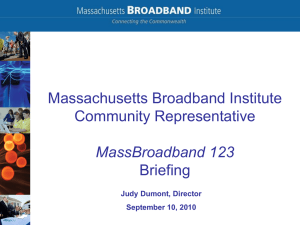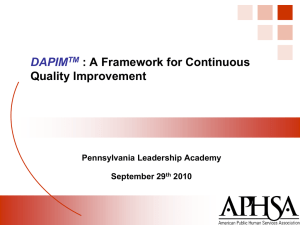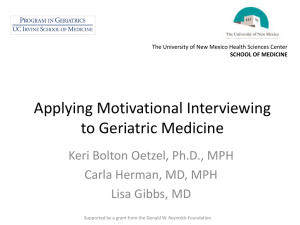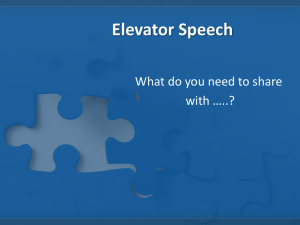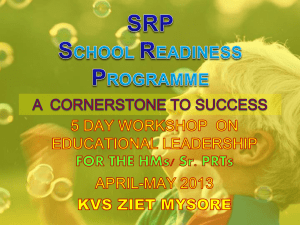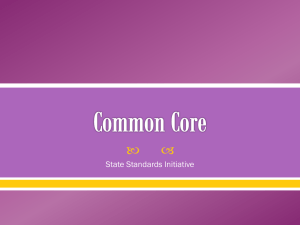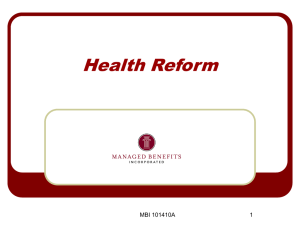the Powerpoint Presentation
advertisement
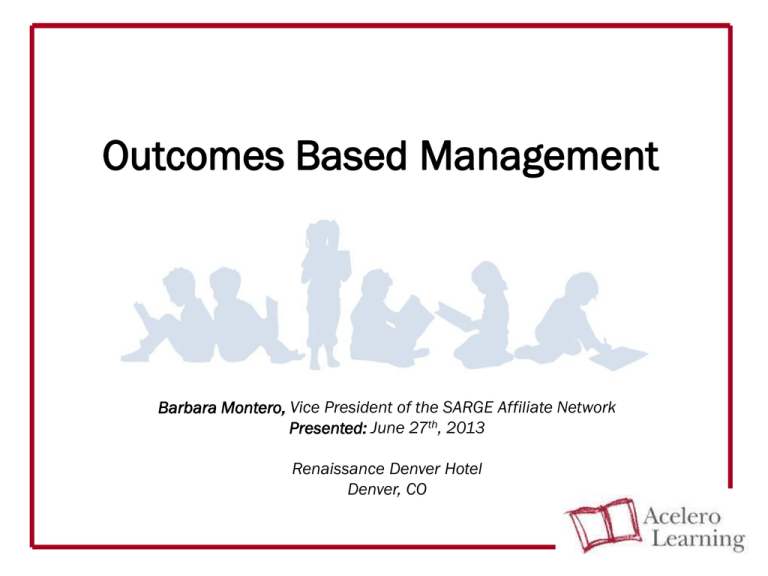
Outcomes Based Management Barbara Montero, Vice President of the SARGE Affiliate Network Presented: June 27th, 2013 Renaissance Denver Hotel Denver, CO Introductions & Background Mission of Acelero Learning The mission of Acelero Learning is to bring a relentless focus on positive child and family outcomes to close the achievement gap and build a better future for children, families, and communities served by the Head Start program. What is Acelero Learning? Acelero Learning is a proud provider of Head Start/Early Head Start and other comprehensive early child programs. We were founded in 2001 (by a former Head Start teacher & a former Children’s Defense Fund staffer) and we partner with local communities to manage the highest quality Head Start/Early Head Start programs. Today, we directly administer a network of Head Starts/Early Head Starts and other early childhood programs serving more than 4000 young children and families around the country. Our National Support Center (based in Harlem, NY), supports 3 local delegates in Monmouth/Middlesex, NJ; Camden, NJ/Philadelphia, PA; and Clark County, NV. Acelero Learning Team Aaron Lieberman CEO Henry Wilde SVP of Operations Ellen Frede SVP of Education Lori Levine SVP of HS Services Barbara Montero VP of SAN Former Head Start teacher, CDA holder Founder and CEO of Jumpstart Chairman of SchoolSuccess.net, designed and built first on-line assessment system for HighScope and Teaching Strategies State of Wisconsin Deputy Secretary for Children and Families overseeing childcare under Governor Doyle Former special assistant to Marian Wright Edelman at the Children’s Defense Fund Architect of the NJ Abbott Pre-K program and evaluation system Co-director of National Institute for Early Education Research Former Head Start teacher, HighScope Training of Trainers codesigner Queens Borough Commissioner for Child Protection, NYC Administration for Children’s Services Deputy Director, Free to Grow, National Program Office, Columbia University SPH, a 20-site national Head Start demonstration program Manages the T/TA network of Acelero partner programs/customers Deputy Head Start Director for Clark County (Las Vegas), NV What is Acelero Learning Training and T/A? In-person trainings • • 1.5 to 2-day in-person trainings, typically sponsored in partnership with NHSA and/or Regional Head Start Associations We have trained over 500 Head Start leaders over the last three years in using data to monitor and our outcomes-driven approach SARGE • • • A comprehensive online library of service area plans, policies and tools to assist Head Start and Early Head Start programs in providing high-quality services and achieving Head Start compliance with huge time savings Over 90 Head Start programs (serving nearly 80,000 children and families) are SARGE subscribers, and 80% renew year after year Currently has an optional Re-competition Resources, and a new series of Transition Resources coming soon! SARGE Affiliate Network • • Provides intensive partnerships with a limited number of programs for extensive RFP assistance and ongoing support in PDM, ECE, and FCP We currently work with 8 programs serving over 20,000 children each year Introduction to Outcomes-Based Management in Head Start Why now? Head Start is under attack. • 2010 House budget proposed a $1 billion cut • Sequestration caused a 5.7% cut for FY2013 funding beginning in March 2013 • Head Start Impact Study shows gains from Head Start are not as great as we would want them to be Clear, demonstrable outcomes are more important than ever before! The decisions made in this room directly impact the lives of thousands of children and families! *Concentrate * Focus * * Participate * Agenda Cornerstone #1 • A Look into Innovative Programs and their Outcomes Cornerstone #2 • Using Data to Make Decisions – A Head Start Case Study • An Overview of Compliance-Based Monitoring Breakout #1 • Moving Beyond Compliance into Outcomes-Based Monitoring (School Readiness & Parent, Family & Community Engagement Framework) Breakout #2 • Strategy & Goal-Setting, Family Engagement A Look at Innovative Programs and their Outcomes ECE Innovations that Achieved Outcomes Older with Proven Long-Term Benefits • High/Scope Perry Preschool Project • Abecedarian Project • Chicago Child Parent Centers High/Scope Perry Preschool What was innovative? Four half days of center-based education, school year only One 1.5 hour home visit per week Extremely qualified staff 1:6 ratio Cost: $11,300 per child per school year (in 2007 dollars) What were immediate effects on child outcomes? .8 effect size on the PPVT High/Scope Perry Preschool What were the long-term effects on child outcomes? Educational Effects Berrueta-Clement, J.R., Schweinhart, L.J., Barnett, W.S., Epstein, A.S., & Weikart, D.P. (1984). Changed lives: The effects of the Perry Preschool Program on youths through age 19. Ypsilanti, MI: High/Scope Press. High/Scope Perry Preschool Economic Effects at 40 Schweinhart, L. J., Montie, J., Xiang, Z., Barnett, W. S., Belfield, C. R., & Nores, M. (2005). Lifetime effects: The High/Scope Perry Preschool study through age 40 (Monographs of the High/Scope Educational Research Foundation, 14). Ypsilanti, MI: High/Scope Educational Research Foundation. High/Scope Perry Preschool Crime Effects at 40 Schweinhart, L. J., Montie, J., Xiang, Z., Barnett, W. S., Belfield, C. R., & Nores, M. (2005). Lifetime effects: The High/Scope Perry Preschool study through age 40 (Monographs of the High/Scope Educational Research Foundation, 14). Ypsilanti, MI: High/Scope Educational Research Foundation. Abecedarian Project What was innovative? Full-day, full-year center-based services for children Served children between birth and five years old Home visits Low teacher ratio, 1:3 for infants and 1:6 for five year olds Cost: $17,099 per child in 2011 dollars What were the immediate effects on child outcomes? .79 effect size on reading achievement with IQ Campbell, F. A., Pungello, E. P., Miller-Johnson, S., Burchinal, M., & Ramey, C. T. (2001). The development of cognitive and academic abilities: Growth curves from an early childhood educational experiment. Developmental Psychology, 37(2), 231-242. Abecedarian Project What were the long-term effects on child outcomes? Academic Benefits Barnett, W. S., & Masse, L. N. (2007). Early childhood program design and economic returns: Comparative benefit-cost analysis of the Abecedarian program and policy implications, Economics of Education Review, 26, 113-125; Campbell, F.A., Ramey, C.T., Pungello, E., Sparling, J., & Miller-Johnson, S. ( 2002). Early childhood education: Young adult outcomes from the Abecedarian Project. Applied Developmental Science, 6(1), 42-57. Chicago Child Parent Centers What was innovative? Half day center-based services school year only 17:2 child to teacher ratio in preschool ½ day a week of parent involvement, home visits Cost: $8,700 in 2007 dollars What were the immediate effects on child outcomes? Age 5 Kindergarten Readiness at 47th Percentile (vs. 28th Percentile for comparison group) Chicago Child Parent Centers What were the long-term effects on child outcomes? Academic and Social Benefits at School Exit Temple, J. A., & Reynolds, A. J. (2007). Benefits and costs of investments in preschool education: Evidence from the Child-Parent Centers and related programs. Economics of Education Review, 26(1), 126-144 Meta-Analysis of Pre-K Data What was it? Meta-Analysis of the Effects of Early Education Interventions on Cognitive and Social Development • Gregory Camilli, Sadako Vargas, Sharon Ryan, & W. Steven Barnett Looked at 123 different intervention studies over last 50 years to synthesize their outcomes Goal was to determine the potential benefits and costs of implementing specific preschool programs Meta-Analysis: What Determines Cognitive Gains? Time of Follow-Up Research Design Quality Intentional Teaching Individualization (Small groups and 1-on-1) Comprehensive Services n= 123 Studies Barnett, W. S., (Nov. 13, 2012). Investing in Early childhood Education and Care (ECEC) Negative Positive Positive Positive Negative Meta-Analysis: What Produces The Most Significant Gains? All Designs HQ Designs HQ Programs 1 0.9 0.8 Effects (sd) 0.7 0.6 0.5 0.4 0.3 0.2 0.1 0 Treatment End Ages 5-10 Age at Follow-Up Barnett, W. S., (Nov. 13, 2012). Investing in Early childhood Education and Care (ECEC) Age >10 So what programs have weak or inconclusive results? Multi-generation and home-visiting programs • Even Start unless combined with high quality preschool • Home Based • Parent Child Development Centers K-3 interventions • Follow Through • Project Developmental Continuity • Head Start Transition Study One possible conclusion: education has the biggest impact on education especially when added to no education Current Innovations that are Demonstrating Outcomes • • • • Educare AppleTree Acelero Learning Who Else? Educare What is innovative? Full-day, full-year birth-to-five education services Maintain small class size and high staff/child ratios • Infant-toddler - 3:8 per classroom • Preschool rooms - 3:17 per classroom Maintain high staff qualifications, Master Teachers with advanced degrees in early childhood supervise 3 or 4 classrooms Provide continuity of care, primary teachers remain with children for 3 years, from birth to 3 years old Second team remains with children from ages 3 to 5 Cost: $18,000 to $20,000 per year Educare What were the immediate effects on child outcomes? • Average exiting score of 95 points on the PPVT for non-ELL children (82.5 for DLL) • Children had a higher PPVT score the longer the more years they stayed in Educare Educare Educare Implementation Study Findings – August 2012. “Results.” http://www.educareschools.org/about/pdfs/Demonstrating-Results.pdf AppleTree What is innovative? Lead teachers with a Bachelor’s degree, three teachers in every classroom Low child-to-teacher ratios between 5:1 and 7:1 Full-day program, school year only Direct assessment progress monitoring every 6 weeks Weekly coaching for teachers What were the immediate effects on child outcomes? Average of 99 on the PPVT for 3 year olds with 1 year Average of 93 on the PPVT for 4 year olds with 1 year .53 effect size on the PPVT AppleTree “The AppleTree Approach to School Readiness: A Case Study Using A Longitudinal Population-Referenced Evaluation Framework. “By Craig T. Ramey & Nancy Cromwell. August 2010. “Results.” http://www.appletreeinstitute.org/files/doc/AppleTreeApproach.pdf Acelero Learning What is innovative? Full-day, full-year Highly-credentialed staff, 75% with Bachelor’s degrees Extensive use of data • Weekly MBI report with 100 different summary indicators • Monthly MBI + report with 54 different indicators • Quarterly MBO report looking at outcomes in education, family services and health An ECE focus on coaching, data, and curriculum An FCE focus on giving families more information, and having a common approach to family life practice goals Cost: Head Start funding of $8250 per child Acelero Learning Results Our Results: In our latest evaluation report, returning children enrolled for one full year in our Head Start programs achieve 3.5 times the average gains recorded on the 2009 Head Start FACES study on the Peabody Picture Vocabulary Test (PPVT). So How Does It All Stack Up? PPVT Effect Size by Program * Perry Preschool Study FACES Study (2009) Acelero Learning 8 State UPK Acelero Learning 8 State UPK Perry Preschool Study FACES Study (2009) 0 0.2 0.4 0.6 0.8 1 *Caution should be used in drawing conclusions from these comparisons since the research designs were not the same. Innovations Within Your Programs 1. Look for research-based, proven approaches 2. Pilot to gain experience, test ideas on small scale 3. If successful, evaluate, modify, and expand scope 4. Do not let history dictate your plan for next year! “It is our attitude at the beginning of a difficult task which, more than anything else, will affect its successful outcome.” - William James But remember…. It is never about just ONE thing! • Focus on Coaching, Curriculum, Families, Data… In the end, everything comes down to intensity and focus. Southwest Airlines vs. Ted Generating great outcomes is not a function of one decision you make, but the sum total of EVERY decision you make. Using Data to Make Decisions: Head Start Case Study Introduction: Using Data DATA da·ta ’dā-tə, ‘da-tə n. pl. Factual information (as measurements or statistics) used as a basis for reasoning, discussion, or calculation Merriam-Webster Online Dictionary, www.merriam-webster.com How Do We Use Data to Make Decisions… … at home? … at work? Case Study: PFT Head Start PROCESS: Read case study individually. Review and summarize key points together. In groups, discuss & identify one solution for program improvement. i.e. What would you address, and how? Report out to the group. Case Study: Key Points RM Teacher Asst Teacher F.A. Butterflies (Atkins) Veteran; initially skeptical of curric., now enthusiastic (Perez) Recently hired; open relationship w/ teacher (Jones) Can-do attitude, works well w/ team Ladybugs (Berrera) Recently hired; excited abt curric.; eager to learn and share ideas (Smith) Veteran; comfortable relationship w/ teacher (Watson) Works easily w/ team, integration of family svcs in classroom Case Study: Key Points (cont’d) RM Teacher Asst Teacher F.A. Bluebirds (Cortines) Veteran; does just enough; intimidating (Vasquez) Recently hired; timid; follows teacher rather than speaking up (Jones) Keeps his distance; gives in to teacher; has asked supervisor for help Bunnies (DeNardo) Recently hired; overwhelmed by paperwork; little contact w/ FA (Simpson) Veteran; competent, quiet, few contributions (Watson) Little contact w/ teacher; says disorganization affects her work; frustrated Case Study: Solutions Case Study: Solutions Case Study “Plus” – Exhibit A Case Study “Plus” – Exhibit B Case Study “Plus” – Exhibit C Case Study “Plus” – Exhibit D Case Study “Plus”: Solutions Case Study Reflection Compare discussion/solution #1 (based on case study only) and discussion/solution #2 (based on case study + data). What were the key differences … • In your proposed solutions (results)? • In the discussion itself (process)? • In how you felt about it (relationships)? Summary of Key Points Managing with data enables us to make more objective evaluations/comparisons and more informed choices. We can “manage by exception” and allocate resources more strategically. Using data, we typically identify problems and generate solutions in a more specific, focused and effective way. An Overview of Compliance-Based Monitoring: Manage By Information (MBI) Basics What is the Manage by Information (MBI) report? Literally, the MBI is a reporting tool which measures Head Start compliance indicators Key Aspects of an MBI: Should include information by unit that is managed to and held accountable for results (i.e. classroom, or center, or zone, etc.) Should show trends from prior month (or time period) Should evolve over time as you use Should be used as both a tool to identify areas that need more support and to hold people accountable To be effective, information must be up to date, real-time and run every other week (or monthly, at a minimum) Importance of Using Data to Manage Managing with data enables us to make more objective evaluations/comparisons and more informed choices We can “manage by exception” and allocate resources more strategically Using data, we typically identify problems and generate solutions in a more specific, focused and effective way A Sample Section of the MBI Rows represent centers and the dark purple row shows the program average or total. Columns are numbered sequentially for reference Historical trend data is included at the bottom. Conditional formatting with colors help visually highlight areas. Types of data to enter, capture, and monitor ERSEA • Current enrollment, openings, waitlist • Eligibility, by category Disabilities / Mental Health • Active IEPs / IFSPs • Completed or incomplete or past-due screenings (Dev and SE) Family Services • Completed Strength Assessments and Family Partnership Agreements Health • Completed, Past-Due, Expired Health Screenings and Immunizations • Medical / Dental Homes Early Learning • Completed Home Visits and Parent/Teacher Conferences • Completed Assessments, by checkpoint Don’t forget to capture and review follow-up, as that is also a requirement Can be absolute numbers and/or percentages De-Mystifying the MBI It’s a manual process! • Use of an excel spreadsheet, with pre-populated formulas and conditional formatting • Report running via your data system (COPA, Child Plus) • Entering data into pre-formatted excel worksheet • Creating a simplified and brief analysis to include in the distribution MBI Relies on Accurate, Current Data in Your Systems If it is not in _________ (Child Plus, PROMIS, COPA, etc.) it did not happen! MBI Exercise: Leadership Team Meeting Simulation 1. Get in groups of ten 2. Assign each person one of six roles: • • • • • • Director ERSEA Coordinator Disabilities/MH Coordinator Family Services Coordinator Health Coordinator Early Learning Coordinator 3. Each person reviews data for their area; if time permits, you can review additional areas 4. Directors come up front and meet with me 5. Each coordinator should prepare their report to be shared with the team based on their review of data MBI Exercise: Leadership Team Meeting Simulation How does this compare with your typical Leadership Team meeting? What were the differences? Why? Managing by Information Not just reporting, but acting… Distribution of MBI report among key leaders and governance groups increases accountability for all players Ideally allows leadership to focus on data – not personalities – in problem solving and tracking progress Ultimately it is about identifying problem areas, and then making changes to improve, when key numbers indicate concerns Use of child and family system (criteria 1 from the Program Use of Data Rubric) Inadequate Beginning Implementing No electronic system is in place, all child and family information is paperbased. An electronic child and family data system (Child Plus, COPA, PROMIS, etc) is in place, and used for basic child and family information. Child and family data system is used to track most program services, including family services, health and disability follow up. Mastering Child and family data system is used to track ALL program services, and a review of electronic records effectively “tells the story” of all interactions with each child and family. Next Steps for Creating Your Own MBI: Beginning Re-look at where your program is on the program use of data rubric • Recommended: do it as an exercise with your leadership team If your program is at BEGINNING, identify steps to: • Verify accuracy of currently captured data • Identify the initial items (10-15) you want to include on your initial MBI (use following slides to guide you) • Plan to expand use of data system to include family services info Next Steps for Creating Your Own MBI: Beginning Verify accuracy of currently captured data • Audit paper files with info in Child Plus to assess accuracy • Sample # of files but person responsible for input (family service worker, etc.) • Have coordinators review reports to assess if data is being entered in a consistent fashion With your management team, identify 10-15 items you want to look at every month Agree on rows (items) and columns (centers, delegates, classrooms?) Next Steps for Creating Your Own MBI: Beginning Plan to expand use of data system to include family services info • Focus on service area by service area • Provide specific guidance on HOW to track each item in your data system • Pilot in small groups, get the kinks out, and expand! Use of child and family system Inadequate Beginning Implementing No electronic system is in place, all child and family information is paperbased. An electronic child and family data system (Child Plus, COPA, PROMIS, etc) is in place, and used for basic child and family information. Child and family data system is used to track most program services, including family services, health and disability follow up. Mastering Child and family data system is used to track ALL program services, and a review of electronic records effectively “tells the story” of all interactions with each child and family. Next Steps for Creating Your Own MBI: Implementing If your program is at IMPLEMENTING, identify steps to: • Identify initial items (20+) you want to include on your initial MBI • Shoot for a frequency of every two weeks • Plan to expand use of data system to include any program services not currently captured Use of child and family system Inadequate Beginning Implementing No electronic system is in place, all child and family information is paperbased. An electronic child and family data system (Child Plus, COPA, PROMIS, etc) is in place, and used for basic child and family information. Child and family data system is used to track most program services, including family services, health and disability follow up. Mastering Child and family data system is used to track ALL program services, and a review of electronic records effectively “tells the story” of all interactions with each child and family. Next Steps for Creating Your Own MBI: Mastering If your program is at MASTERING: • Look at other measures, beyond compliance • Next steps may be data-base customization through special filters, user defined field, custom reports, etc. For Mastering: MBI Report: The Next Generation Here is a sample from the 15 new Indicators for our MBI: • # Children Absent 20-49% of days in last 4 weeks • # Children Absent >50% of days in last 4 weeks • # Children Late (15 mins after start time) in last 30 days • # of Children with an Expired IEP • # of Parent/Staff Concern without follow-up in 30 days • # Families in Emergency/Crisis with no follow-up in 30 days MBI: What to expect? When you first run (and distribute) the MBI, this is what will happen: The screenings are done, but I did not have a chance to put them in the computer! But this info is not correct! I put them in the stupid computer and they are not showing up! MBI: How You Should Respond Help people understand how the system works Build a culture of “low stakes” for first few MBIs Let people know we will get it right! That must be frustrating! Let’s’ dig in and see where the process broke down. Remember – getting in the system is the last step in doing the screening! Let’s trouble shoot to see how we get the data in on time before the report is run. Your Commitment Managing By Information Within the next three days I will… Within the next 30 days I will… Outcomes-Based Monitoring: Managing By Outcomes (MBO) A Review: What is the Manage by Information (MBI) report? The MBI is a reporting tool which measures Head Start compliance indicators Key Aspects of an MBI: Should include information by unit that is managed to and held accountable for results (i.e. classroom, or center, or zone, etc.) Should show trends from prior month (or time period) Should evolve over time as you use it Should be used as both a tool to identify areas that need more support and to hold people accountable To be effective, information must be up to date, real-time and run monthly, at a minimum The MBI: The Limitations Almost exclusively focused on process indicators (in comparison to outcomes) Are short-term by nature – things that change every week Can lead you to “miss the forest for the trees” if there are no other measurement systems in place The MBI: The Limitations For example… • What if we conduct all of your educational assessments, but children are leaving our program not prepared for kindergarten? • What if we complete our family partnership agreements on time, but our families never meet those goals? • What if we finish all our screenings on time, but never successfully help families follow-up on health issues? Managing by Outcomes Why it is needed… The Head Start Performance Standards, and the corresponding OHS monitoring process, are almost completely focused on PROCESS and COMPLIANCE, not outcomes Only with the recent focus on School Readiness Goals has OHS ever even asked to see outcome reports! For that reason, to be a GREAT Head Start program, it is NOT ENOUGH to just meet the Head Start Performance Standards Head Start Performance Standards are a floor, not a ceiling! Managing by Outcomes What it does… The MBO Report allows us to: • Set program-wide goals for key outcomes we want to accomplish • Manage and measure to see if we accomplish them, and how we can improve • Review these outcome reports quarterly throughout the year, and adjust our work accordingly Introduction to Outcomes OUTCOME out·come Pronunciation: \au̇t-kəm\ Function: noun Date: 1788 : something that follows as a result or consequence Merriam-Webster Online Dictionary Word origin: 1788, "that which results from something," originally Scottish, from out + come (v.). From Dictionary.com Managing by Outcomes Process vs. Outcome Process Completing assessments on time Outcome Children mastering skills Completing family strengths assessments Families achieving goals Completing required screenings on time Children receiving treatment to help them become healthier! Managing by Outcomes How do we choose? In Head Start, choosing key outcomes to focus on is a HUGE challenge The Head Start Performance Standards mandate many different processes, most of which (hopefully) have corresponding positive outcomes, but we cannot track everything While we have to have school readiness goals, there is no one definitive way to do this We have chosen to focus on three areas that we think are essential for Head Start programs: child, family, and health outcomes Three Key Outcome Areas Child Outcomes What will our children be able to do as a result of our program? Now: School Readiness Goals Family Outcomes What will our families accomplish as a result of our program? Now: PFCE Outcomes Health Outcomes How will our children be healthier as a result of our program? Key Elements of Manage by Outcomes Each outcome should focus on what will be different as a result of your program For each outcome, you identify specific objectives, measures, and targets Objectives What is the goal? Measure How will you measure it? Target What is the specific level you want to achieve based on your measure? Exercise: School Readiness Goals Objective: Measure: Children enter kindergarten prepared to succeed Target: Objectives What is the goal? • We chose three domains of our school readiness goals that we thought were crucial for positive child outcomes • Within each domain, we identified an average score that would indicate “mastery” (i.e., where we wanted children to be upon transitioning to kindergarten) Measure How will you measure it? Target What is the specific level you want to achieve based on your measure? • We chose whatever assessment system the program was using (GOLD, WSS, ELS) as the measure • We chose a specific % of children (i.e. 90%) that we want to reach the mastery level Objectives, Measures and Targets OHS Guidance on School Readiness Goals Each agency should aggregate and analyze assessment data at multiple points in a year and use that data in combination with other program data to: Determine progress toward meeting the established goals; Inform parents and the community of results; Direct continuous program improvements related to curriculum, teaching, and instructional strategies, professional development, program design, and other program decisions; OHS Guidance on School Readiness Goals OHS recommends that agencies aggregate and analyze assessment data at least three times during the year (to provide baseline, midpoint, and year end progress); or, for programs operating 90 days or less, two times during the program OHS recommends programs use data in combination with input from parents and families to determine each child's status and progress with regard to, at a minimum, language and literacy, cognition and general knowledge, approaches toward learning, physical well-being and motor development, and social and emotional development, and to individualize the experiences, teaching, and services to best support each child. Use of Data on Child Outcomes for School Readiness (criteria 3 from the Program Use of Data Rubric) Inadequate Beginning Implementing Mastering Data on child outcomes is not used for school readiness goals. Data on child outcomes is used for assessing progress on school readiness goals at least three times per year at the program level. Data on child outcomes is used for assessing progress on school readiness goals three times a year at the program, center, and classroom level. There is quality assurance process in place to understand reliability of child outcome data. Data on child outcomes is used to measure progress toward a “school ready” target, and data is analyzed at the classroom and child level to help teachers individualize. Quality assurance process confirms data is accurate. School Readiness Goals At the Program, Center, and Child Level At the program level • • • • • Delegate gets roll-up of child outcome data Reviewed by leadership team and education leadership team Demonstrates global trends Likely least useful view Break out by program options or other sub-groups as much as possible (OHS requirement) At the center level • Allows you to see differences by center • Ultimately, you want to see data by the person who is accountable -- for us that is center directors • Helps education staff troubleshoot and prioritize School Readiness Goals At the Program, Center, and Child Level, cont. At the child level • • • • Ultimately, this is the most useful view Should help teachers differentiate instruction Should help center directors focus coaching/problem solving Ultimately, teacher is accountable for reaching school readiness goals Quality Assurance Process To Understand Reliability of Child Outcome Data Look closely: These are complicated systems! • • • • Sample each teacher’s data in the system Look at quality of observations (specific, objective, factual) Verify assessment item(s) to which the observation is assigned Assess accuracy of scoring (the level teacher chose for each item) What % of child assessment data is truly accurate? • Less than 50%? Do not start analyzing outcome data • Ensure all teachers are reliable. Some systems now have built-in reliability (GOLD, ELS). • Explore opportunities to streamline assessment process Repeat! Use of Data on Child Outcomes for School Readiness (criteria 3 from the Program Use of Data Rubric) Inadequate Beginning Implementing Mastering Data on child outcomes is not used for school readiness goals. Data on child outcomes is used for assessing progress on school readiness goals at least three times per year at the program level. Data on child outcomes is used for assessing progress on school readiness goals three times a year at the program, center, and classroom level. There is quality assurance process in place to understand reliability of child outcome data. Data on child outcomes is used to measure progress toward a “school ready” target, and data is analyzed at the classroom and child level to help teachers individualize. Quality assurance process confirms data is accurate. School Readiness Goals Are Used to Measure Progress Toward A “School Ready” Target Set a TARGET for what % of children you want to reach your School Readiness Goals • Must separate out data between three year olds and four year olds • Again, look at data by program, center, and classroom level If your data is accurate • Time 1 tells you where you need to focus (baseline) • Time 2 tells you the score at half-time -- need it quickly to make mid-course adjustments • Time 3 tells you where children are at the end of the year The MBO and Parent, Family & Community Engagement Outcome Goals Sample MBI Family Measures The MBI : The Limitations For example… • What if we complete all of our Family Partnership Agreements, but families don’t ever meet their goals? • What if we captured that families received services, but those services didn’t provide the support necessary to stabilize or meet the families long term needs? • What if parents attended a workshop on job readiness, but never actually looked for, or secured a job? Managing by Outcomes Why it is needed for families… The Office of Head Start has not yet integrated Family Outcomes into any of the monitoring systems, but… The recently released Parent Family Community Engagement Framework identified seven family outcomes areas The links in the research between child and family outcomes suggest that HS programs will not achieve school readiness goals without a more intensive focus on targeted family outcomes To be a great HS program we should be leveraging HS’s two generation model to achieve significant family impact that will enhance children’s lives longer after they leave HS Key Outcome Areas Child Outcomes What will our children be able to do as a result of our program? Now: School Readiness Goals Family Outcomes What will our families accomplish as a result of our program? Now: PFCE Outcomes Health Outcomes How will our children be healthier as a result of our program? Family Outcomes How do we choose? In Head Start, choosing key outcomes to focus on is a HUGE challenge The Head Start Performance Standards mandate many different processes, most of which (hopefully) have corresponding positive outcomes, but we cannot track everything There are currently no expectations set by the OHS for tracking family outcomes We’ve started simply, with expectations to seek other external measures that better capture behavioral change as our work progresses Exercise: PFCE Goal Objective: Families leave our program prepared to support their child’s future success. Measure: Target: Objectives What is the goal? • We chose four domains of family outcomes that research links with positive child outcomes • Within each domain, we chose to track progress so that we could help staff track benchmarks towards family outcomes Measure How will you measure it? Target What is the specific level you want to achieve based on your measure? • We chose to link our measurements to our Family Strengths Assessment and goal setting data • We set targets of %ages of families where we hoped to see progress and tested other measures before setting targets Objectives, Measures and Targets Tracking tangible family outcomes – such as securing a job or completing a GED Office of Head Start Parent, Family and Community Engagement Framework From the PFCE Framework The PFCE is a roadmap for progress in achieving the types of outcomes that lead to positive and enduring change for children and families When parent and family engagement activities are systemic and integrated across program foundations and program impact areas, family engagement outcomes are achieved, resulting in children who are healthy and ready for school Parent and family engagement activities are grounded in positive, ongoing, and goal-oriented relationships with families PFCE Framework: Research-Based Families play a critical role in helping their children to prepare for school and a lifetime of academic success. Research indicates that: Children with supportive home learning environments show increased literacy development, better peer interactions, fewer behavior problems, and more motivation and persistence during learning activities Among the youngest children, daily parent-child reading from infancy prompts cognitive skills as well as early vocabulary gains that lead to more reading and vocabulary growth, a pattern of growth that has been compared to a snowball Continued family engagement is important through the school years. Longitudinal studies of low-income children show that high family involvement offsets the risks of children growing up in lowincome households and in households with low parent education OHS PFCE Framework and Acelero Learning’s Family Services Approach Targets explicit family outcomes Managing By Outcomes, Step 1 Objectives What is the goal? Simply put, our objective is assisting families to achieve outcomes in four areas: • Family Life Practices • Self-Sufficiency • Supporting Children with Chronic Health Conditions and IEP’s/IFSP’s • Stabilizing families in crisis and reducing the impact of substance abuse, depression, domestic violence on young children’s development Managing By Outcomes, Step 2 Measure How will you measure it? Pre/Post Family Strengths Assessment: • We assess families at the beginning and end of program year and track changes in family circumstances Goal Progress: • We track progress on family goals in each of the four areas Goal Attainment: • We track #’s of families who have achieved tangible selfsufficiency outcomes, such as GED completion, securing a job, English proficiency Use of Data for Family Outcomes (criteria 4 from the Program Use of Data Rubric) Inadequate Beginning Implementing Mastering There is no process in place to quantify or track progress on family goals. There is a process in place to track and quantify progress on family goals that helps standardize progress measures with similar goals. There is a process in place to track and quantify progress on all family goals, and data is run and analyzed at the program level and family advocate level. There is a quality assurance process in place to understand reliability of family outcome data. Family goal progress is used to measure progress toward a program-wide target. Family outcome data is regularly analyzed on the family, advocate, and program level. Quality assurance process confirms data is accurate. Family Outcomes At the Program and Center At the program level • Delegate gets roll-up of family outcome data • Reviewed by leadership team and family services leadership team • Demonstrates global trends, but hard to see differences in family engagement across workers/Centers At the center level • Allows you to see differences by center • Ultimately, you want to see the data by persons responsible – by Advocate and FSC • Allows us to see trends among workers and supervision Use of Data for Family Outcomes (criteria 4 from the Program Use of Data Rubric) Inadequate Beginning Implementing Mastering There is no process in place to quantify or track progress on family goals. There is a process in place to track and quantify progress on family goals that helps standardize progress measures with similar goals. There is a process in place to track and quantify progress on all family goals, and data is run and analyzed at the program level and family advocate level. There is a quality assurance process in place to understand reliability of family outcome data. Family goal progress is used to measure progress toward a program-wide target. Family outcome data is regularly analyzed on the family, advocate, and program level. Quality assurance process confirms data is accurate. Quality Assurance Process To Understand Reliability of Family Outcome Data Look closely: These systems rely on accurate data! First the family strengths assessment • Look at FSA trend data across programs, Centers and Advocates to compare to level of need one would expect to see based upon family demographics • Conduct qualitative audits of FSA instruments to assess accuracy of family assessment scoring • Review stratified sample of goal setting data to assess accuracy of reporting of goal progress • Utilize reliability data to inform professional development and supervision Managing By Outcomes & Health Outcome Goals The MBI: The Limitations For example… • What if we finish all our screenings on time, but never successfully help families follow-up on health issues? • What if we screen children, but never follow-up to ensure children receive the appropriate Disabilities and/or Mental Health services? Three Key Outcome Areas Child Outcomes What will our children be able to do as a result of our program? Now: School Readiness Goals Family Outcomes What will our families accomplish as a result of our program? Now: PFCE Outcomes Health Outcomes How will our children be healthier as a result of our program? Key Elements of Manage by Outcomes Each outcome should focus on what will be different as a result of your program For each outcome, you identify specific objectives, measures, and targets Objectives What is the goal? Measure How will you measure it? Target What is the specific level you want to achieve based on your measure? Health Outcomes How do we choose? In Head Start, choosing key outcomes to focus on is a HUGE challenge The Head Start Performance Standards mandate many different processes, most of which (hopefully) have corresponding positive outcomes, but we cannot track everything We’ve started simply, with a focus on health indicators that are reported in the PIR, with a few “beyond Z” innovations. We focus on how quickly we get children in treatment, and we focus on measuring our success at helping resolve obesity issues for our children Exercise: Health Services Outcome Goal Objective: Measure: Children are healthy (or healthier) when they leave our program. Target: Objectives What is the goal? Measure How will you measure it? Target What is the specific level you want to achieve based on your measure? • We chose five areas of health follow up that are critical to a child’s healthy development •Within each area, we track whether or not children are receiving treatment with in set time frames (i.e. 90 days, etc.) • We chose to link our measurements to out internal processes of documenting following-up • We set targets for the % of children we wanted to receive treatment in defined time periods (Q1, Q2, Q3, or Q4) Objectives, Measures and Targets Managing By Outcomes, Step 1 Objectives What is the goal? Simply put, our objective is assisting children and families to receive treatment, with a focus on: • Lead • Hemoglobin/Hematocrit • Dental • Other non-chronic medical (i.e. hearing & vision screenings, accidents, and illnesses) • Obesity Resolution Managing By Outcomes, Step 2 Measure How will you measure it? Health Requirements & Results: • We assess children’s need for treatment, based on the results of their required health requirements Treatment Received: • We track the timing of when a health issue is identified to when treatment is received Obesity • We track the difference in BMI from the fall assessment to the most recent assessment Managing by Outcomes (Health) Why it is needed for children & families… Increasingly, children we serve in our Head Start programs are at risk for experiencing negative health outcomes…. • We are raising a generation of children who are likely to be less healthy than their parents and may even have a shorter life expectancy • Chronic diseases remain the number one factor in poor health outcomes, many of which have their origins in childhood • Over the last three decades, the number of overweight children has more than tripled, and one in every five children has a mental health concern Impact of Healthy Lifestyles on Children’s Development • Poor diets linked to disproportionate rates of obesity, Type 2 Diabetes in low income communities • Access to green space and safe parks, playgrounds impacts socialemotional and gross motor development Impact of Poorly Managed Health Conditions on School Success Asthma is the most common chronic childhood illness affecting approximately 6.3 million (8.7%) children in the United States. Since 1980, the prevalence of asthma has increased by 75%. In inner city communities, as many as one child in three is diagnosed with asthma. Asthma accounts for more school absenteeism than any other chronic disease, and 60% of students with asthma miss school annually due to respiratory symptoms. Research suggests that young children with severe and poorly managed asthma are more likely to repeat a grade or fall behind their peers by third grade Use of Data for Health Outcomes Inadequate Beginning Implementing Mastering There is no process in place to quantify or track results for health requirements. There is a process in place to track and quantify health screenings and follow up that helps standardize timing expectations for follow-up and treatment. There is a process in place to track and quantify health screenings and follow up, and data is run and analyzed at the program level and center level. There is a audit process in place to get qualitative data on health follow up. Health follow-up and treatment is used to measure progress toward a program-wide target. Health outcome data is regularly analyzed on the center, and program level. Quality assurance process confirms data is accurate. Health Outcomes At the Program and Center Level At the program level • Delegate gets roll-up of health outcome data • Reviewed by leadership team and health services leadership team • Demonstrates global trends, but hard to see differences in health treatment across centers At the center level • Allows you to see differences by center • Ultimately, you want to see the data by persons responsible – by Advocate and/or Health Coordinator • Allows us to see trends among workers and supervision Critical Health Audit/Quality Assurance Steps Consistent Data Entry Standards are Critical • Specific, screen by screen guidance is often needed • Flexibility in systems is a detriment to good data Quality Audits are Key • Included survey on understanding health roles and responsibilities • Directors and coordinators sampled records, reviewed for quality and timeliness of follow up Continuous improvement cycle often leads to process improvements Health and Nutrition Take-Aways Health Outcomes directly linked to effective understanding and execution of roles and responsibilities Based on audits, we refined MBI follow-up tracking to bring health execution “out of the shadows” and front and center to all delegates Roles and responsibilities as designed work when they are well-executed! Managing By Outcomes & Mental Health & Disabilities Goal Examples Disabilities & MH Outcomes Managing by Outcomes (Dis. and Mental Health) Why it is needed for children & families… The links in the research between child, health, and mental health outcomes suggest…. • Intense stress linked to poorer child and adult health outcomes, as well as changes in brain maturation • Children’s challenging behavior sometimes a proxy or “warning signal” of family circumstances Things to Think About What data structures do you have in place to track children with chronic health conditions and/or special needs? Could your Family Advocates identify these families on their caseloads? What information do you capture about the status of children’s health conditions? Can you identify those children whose chronic health conditions are affecting their attendance or program participation? What structures do you currently have in place to assess the family dynamics of children with challenging behaviors? How can this intentional goal-setting structure be integrated into existing service coordination systems? • What adaptations/enhancements would be needed? In the long run, men hit only what they aim at. Therefore, they had better aim at something high. Henry David Thoreau Your Commitment Managing By Outcomes Within the next three days I will… Within the next 30 days I will… Thank you VERY much for your participation and attendance in Day 4 of the NHSA Manager & Director Academy! Please keep in touch and remember to network with your Head Start peers (including us!) Acelero Training & Technical Assistance Contacts: Katherine Molina-Powell: katherine@acelero.net Barbara Montero: barbara@acelero.net Like us on Facebook www.facebook.com/acelero to get stay up-to-date on what’s happening in the world of Head Start and to receive info on upcoming Acelero events.
